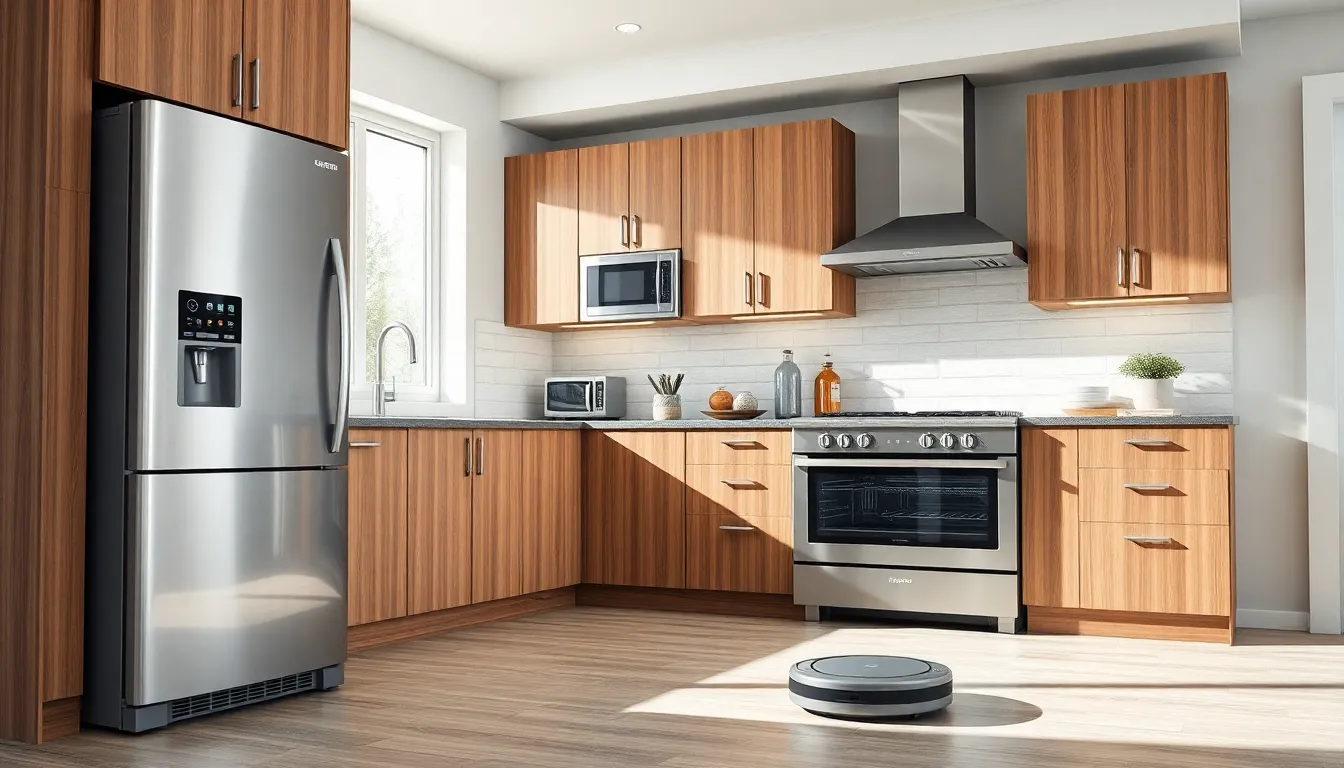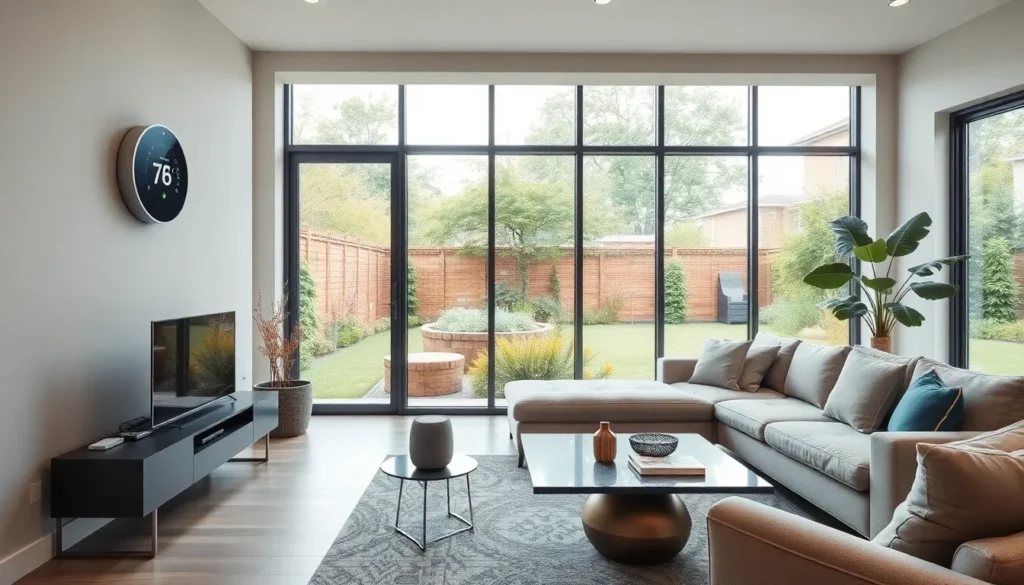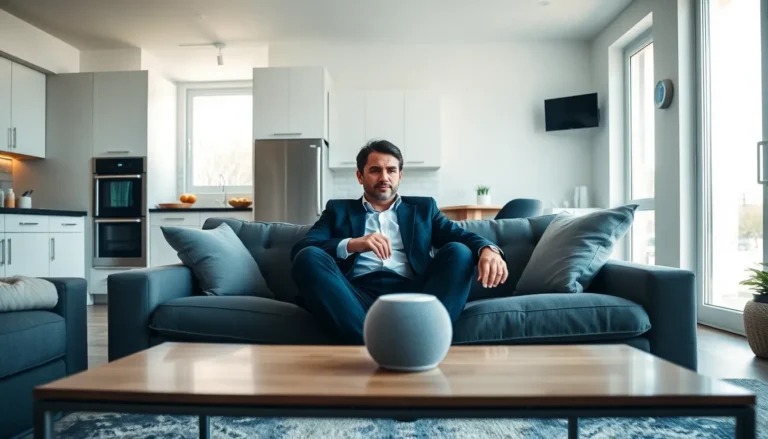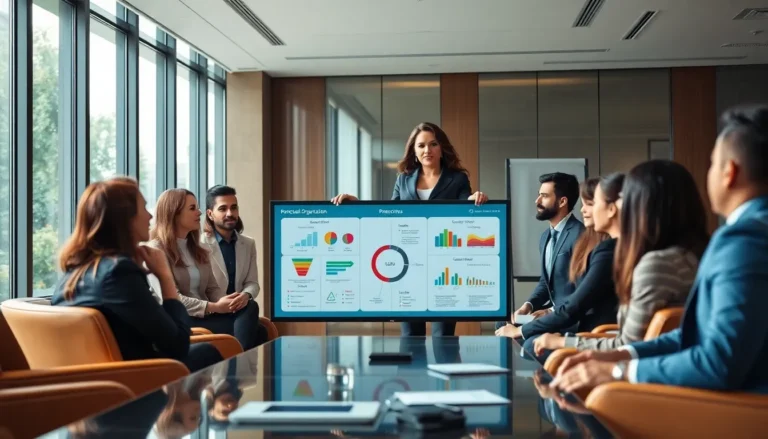The future of home technology is not just a vision; it’s rapidly becoming a reality. As innovation accelerates, homes are transforming into smart ecosystems that enhance comfort, security, and efficiency. From AI-driven appliances to integrated home automation systems, these advancements promise to redefine daily living.
Imagine a home that anticipates needs and adapts to preferences. With the rise of the Internet of Things, devices are becoming interconnected, allowing seamless communication and control. This not only simplifies tasks but also contributes to energy savings and improved safety. As technology continues to evolve, the possibilities for creating a smarter, more sustainable living environment are limitless.
Table of Contents
ToggleFuture Home Technology Overview
Future home technology represents a significant leap in the evolution of residential living. Homes are increasingly becoming interconnected environments, where devices communicate seamlessly to enhance user experience. Automation in lighting, heating, and security systems contributes to increased comfort and reduced energy consumption.
Key Components
- Smart Appliances
Smart refrigerators, ovens, and washing machines automate tasks and offer remote monitoring. They adjust operations based on user preferences, optimizing energy use.
- Integrated Home Automation Systems
These systems enable centralized control of various devices. Homeowners can manage lighting, climate, and security from a single interface, promoting convenience and safety.
- Artificial Intelligence (AI)
AI-powered devices learn user habits, predicting needs to personalize interactions. Smart assistants respond to voice commands, providing information and controlling other devices, streamlining daily routines.
- Internet of Things (IoT)
IoT connects appliances and sensors, enhancing functionality. This network allows for real-time data sharing, enabling proactive maintenance and energy monitoring.
- Energy Management Solutions
Advanced energy management tools track consumption patterns. They allow homeowners to identify savings opportunities and integrate renewable energy sources, fostering sustainable living practices.
Benefits
- Improved Energy Efficiency
Smart home technologies can reduce energy consumption by adjusting to usage patterns and preferences.
- Enhanced Security
Integrated security systems include smart cameras and alarms that provide real-time alerts and remote access, ensuring greater peace of mind.
- Greater Comfort
Automated adjustments in lighting and temperature create a more comfortable living environment tailored to individual needs.
Future Trends
- Sustainable Technologies
Adoption of renewable energy sources and energy-efficient appliances is expected to rise, contributing to eco-friendly home designs.
- Increased Interconnectivity
Future technologies will enable even more devices to connect, enhancing functionality and user experience.
- Focus on Health and Wellness
Home technology solutions are evolving to monitor air quality and provide personalized healthcare insights, promoting healthier living environments.
Future home technology continues to shape the concept of modern living, integrating convenience, sustainability, and safety into everyday spaces.
Smart Home Devices

Smart home devices play a crucial role in creating an integrated living environment. They enhance convenience, security, and energy efficiency, making homes more adaptive to individual needs.
Connected Appliances
Connected appliances automate everyday tasks, providing convenience and efficiency. These devices often utilize Wi-Fi or Bluetooth technology to sync with smartphones or home automation systems, enabling users to control them remotely. Examples include smart refrigerators that monitor inventory and suggest recipes, washing machines that adjust cycles based on fabric types, and ovens that can be preheated from a mobile device. According to a report by MarketsandMarkets, the global smart appliance market is expected to reach $87.26 billion by 2025, highlighting their growing importance in modern households.
Home Security Systems
Home security systems incorporate advanced technology to enhance safety and provide peace of mind. Smart security devices include video doorbells, security cameras, and motion sensors that notify homeowners of unusual activity. Many systems enable remote access through mobile apps, allowing users to monitor their properties in real-time. Notably, a survey from Statista indicates that 68% of homeowners prioritize smart security solutions in their future home technology investments. These systems contribute to an interconnected security approach, where devices communicate to provide comprehensive protection and alerts.
Energy Efficiency Innovations
Energy efficiency innovations significantly impact future home technology. These advancements aim to optimize energy consumption, reduce costs, and promote sustainability.
Solar Energy Solutions
Solar energy solutions facilitate renewable energy adoption in homes. Photovoltaic (PV) panels convert sunlight into electricity, providing a sustainable energy source. Homeowners can save on energy bills while reducing carbon footprints. Systems like solar batteries store excess energy for later use, increasing effectiveness and reliability. According to the U.S. Department of Energy, the cost of solar energy systems has fallen by approximately 70% since 2010, making this technology more accessible.
Smart Thermostats
Smart thermostats enable optimized climate control in residential spaces. These devices learn user behaviors and adjust temperature settings accordingly, enhancing comfort while minimizing energy use. By utilizing sensors and algorithms, smart thermostats can provide significant energy savings; studies show savings up to 10-20% on heating and cooling costs. Features like remote access and integration with other smart devices further enhance usability. Popular models, such as the Nest Learning Thermostat and Ecobee SmartThermostat, allow homeowners to manage energy usage efficiently, contributing to overall energy efficiency in modern homes.
Home Automation Trends
Home automation is evolving rapidly, focusing on enhancing user experience through advanced technology. Modern homes increasingly integrate smart devices, enabling seamless interconnectivity and improved convenience.
Voice-Activated Assistants
Voice-activated assistants play a pivotal role in home automation. Devices like Amazon Echo and Google Nest Hub allow users to control smart home devices using voice commands. They facilitate tasks such as adjusting lighting, setting thermostats, and managing entertainment systems without needing manual interaction. Furthermore, these assistants use natural language processing to learn user preferences, thus offering personalized experiences. The popularity of voice-activated assistants continues to grow, with market penetration projected to reach 2.25 billion units globally by 2025.
Integrated Systems
Integrated systems offer centralized control over home automation devices. These systems combine various technologies—lighting, HVAC, security, and entertainment—into a single platform, enhancing user management. Homeowners can control all connected devices through a smartphone app or a central hub, simplifying operations. Notable platforms include SmartThings and Apple HomeKit, which allow for custom automation routines, such as scheduling lights to turn on at sunset or adjusting temperature settings when leaving home. The streamlined integration not only improves convenience but also promotes energy savings by optimizing device usage.
Virtual and Augmented Reality
Virtual and augmented reality (VR and AR) technologies are transforming home technology, offering innovative ways to design, plan, and experience living environments. These advancements enhance user interaction, making home customization more engaging and efficient.
Home Design and Planning
Home design and planning benefit significantly from VR and AR technologies. Architects and designers use VR to create immersive 3D models, enabling clients to visualize spaces before construction begins. Users can walk through virtual homes, experiencing layouts and design elements in real time. Design software such as SketchUp and Autodesk Revit enables virtual walkthroughs, promoting better collaboration between homeowners and designers. AR applications, like Houzz and IKEA Place, allow users to visualize furniture and décor in their actual space, helping them make informed decisions. This integration of technology enhances the design process, reduces errors, and fosters creativity.
Interactive Displays
Interactive displays play a pivotal role in utilizing VR and AR within home technology. Smart mirrors and touchscreen interfaces create dynamic home environments, providing homeowners with information at their fingertips. These displays can showcase real-time data, such as energy usage, weather updates, or news alerts. Products like the Lenovo Smart Mirror and Samsung’s Family Hub refrigerator exemplify interactive displays in action. By integrating AR features, these devices can project virtual images and applications, enhancing daily tasks and interactions. Homeowners experience convenience and increased engagement through tailored content, making technology a seamless part of their living spaces.
The future of home technology promises to revolutionize everyday living in unprecedented ways. As homes evolve into smart ecosystems, the integration of AI and IoT will redefine convenience, energy efficiency, and security. Homeowners can expect a seamless experience with devices that not only communicate but also adapt to their unique lifestyles.
With a strong focus on sustainability and health, future innovations will prioritize eco-friendly solutions and enhance overall well-being. The advancements in smart appliances, home automation systems, and energy management tools will continue to shape modern living spaces, making them more efficient and secure. Embracing these technologies will lead to a more connected and sustainable future, transforming how individuals interact with their homes.



